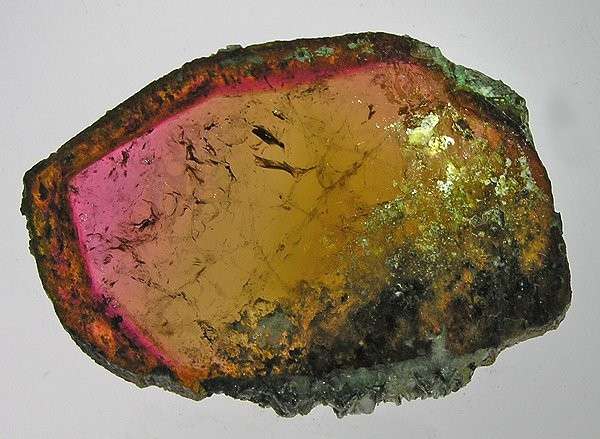
Appearance
The amazing color variety of tourmaline is among its most notable features. Nearly every hue of the rainbow is represented by it, including colorless and green, blue, red, pink, yellow, brown, and black variations. Some tourmalines, known as “bi-color” or “watermelon” tourmalines, can display several colors within a single crystal.
Prism crystals with a triangular cross-section are formed when tourmaline crystallizes in the trigonal system. These crystals might be lengthy columns or stubby hexagonal prisms, depending on their size and shape. Depending on the presence of inclusions and impurities, the crystals might be opaque, translucent, or transparent.
Geographical Distribution
Worldwide, there are deposits of tourmaline in a number of nations, including the US, Brazil, Madagascar, Afghanistan, Nigeria, and Sri Lanka. The variety of tourmaline available on the market is increased by the distinctive color and quality differences that are produced at each site.
History
The word “turmali,” which means “mixed colors” in Sinhala, is where the name “tourmaline” originates. The name perfectly captures the wide variety of colors in the gem. The gemstone has long been recognized by many cultures, but it wasn’t until the 18th century that it became well-known in Europe due to its importation from Sri Lanka.
Metaphysical Properties
Numerous healing and metaphysical qualities have been linked to tourmaline. It is thought that each color of tourmaline has unique energy qualities and is employed for a variety of reasons. For instance, pink tourmaline is frequently linked to love and emotional healing, whilst green tourmaline is linked to physical richness and energy. In complementary and alternative medicine techniques including crystal healing, meditation, and chakra balancing, tourmaline is employed.

Chemical Composition
The complex borosilicate mineral tourmaline’s composition varies according to the particular chemical elements it contains. The typical chemical formula for tourmaline is (Na,Ca)(Li,Mg,Fe^2+,Fe^3+,Mn^2+)_3Al_6(BO_3)_3Si_6O_18(OH,F)_4.
Types
The following are some prominent types and variations of tourmaline:
Rubellite:
A kind of tourmaline known as rubellites has vivid pink to crimson hues. Its deep, rich colors make it one among the most prized and sought-after types of tourmaline.
Indicolite:
The blue type of tourmaline is called indolite. It can have hues ranging from pale blue to rich blue-green. The color saturation and intensity can differ, and some examples have a very noticeable teal or turquoise appearance.
Watermelon Tourmaline:
The phrase “watermelon tourmaline” describes tourmaline crystals with a unique color zoning that resembles a slice of watermelon. The crystals usually have a green outer layer encircling a pink or crimson core. This variety’s distinctive and striking appearance makes it extremely valuable.
Canary Tourmaline:
The colors of canary tourmaline range from brilliant yellow to golden. Because of its brilliant, sunny colors, this cultivar is highly prized and relatively rare.
Chrome Tourmaline:
The beautiful green hues of chrome tourmaline are well-known. The green color is due to the chromium that is present in the crystal structure. The best examples have a deep green that resembles emerald.
Schorl:
The most prevalent and abundant type of tourmaline is schorl. It is extensively utilized in many different industrial applications and is normally dark or black in color.
Bi-Color Tourmaline:
Crystals that display two or more different colors in a single specimen are called bi-color tourmaline. Pink and green, pink and blue, and green and blue are common pairings. Colour zoning can take many different forms, such separate parts or concentric bands.
Cat’s Eye Tourmaline:
An eye of a cat When tourmaline is cut en cabochon, it exhibits chatoyancy, an optical phenomena that results in a pronounced band of light that resembles a cat’s eye. The crystal’s needle-like inclusions align to provide this effect.
Colorless Tourmaline:
Achroite, another name for colorless tourmaline, is a transparent variation that has no discernible color. It can be used in place of diamonds and is prized for its clarity.
Uses
The following are some typical applications for tourmaline:
- Jewelry: As a gemstone, tourmaline is extremely valuable and frequently used in jewelry. It is cut into a variety of shapes, such as beads, cabochons, faceted gemstones, and carved decorations. Tourmaline is a popular material for rings, necklaces, earrings, bracelets, and other jewelry pieces because of its broad color spectrum and distinctive color combinations.
- Electrical and Scientific Applications: Some tourmaline types, like elbaite, have special electrical characteristics. They are pyroelectric and piezoelectric, which means that when they are heated or cooled, they produce an electrical charge. Because of this, tourmaline is used in the manufacturing of delicate electronic parts including sonar equipment, accelerometers, and pressure sensors. Additionally, it is utilized in scientific devices including spectrometers and X-ray detectors.
- Industrial Uses: Schorl, or black tourmaline, is widely employed in many different industrial purposes. In grinding and polishing processes, it serves as an abrasive substance. In addition, schorl is utilized in the creation of mineral specimens, black pigments, and glazes for ceramics.
- Decorative and Collectible Items: Rough and polished specimens of tourmaline are prized for their distinct forms and inherent beauty. They are frequently used in sculpture and art, or used as decorative elements.
- Lapidary and Gemstone Cutting: Gemstone cutters and lapidaries employ tourmaline raw to create cabochons, faceted stones, and other custom-cut gemstones of high quality. Expert craftspeople polish and cut tourmaline to enhance its color, clarity, and shape, turning raw material into polished gemstones suitable for jewelry or collector’s items.
Table





